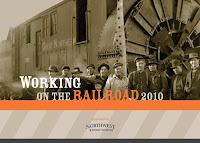Today – March 1, 2010 – is the anniversary of a northwest tragedy: the Wellington Disaster. On March 1, 1910, at about 1:15 AM, an avalanche over ½ mile in length began high above the town of Wellington. The town itself was spared, but two snow-bound trains just west of the depot were swept into the valley below. At least 96 people perished, most of them railroad workers.
 Several great authors have written insightful works about the avalanche, most recently Martin Burwash with his release of Vis Major. Gary Krist wrote The White Cascade: The Great Northern Railway Disaster and America’s Deadliest Avalanche and an excellent profile of Gary and what precipitated his writing adventure was detailed by Phoebe Snow. And Gary will be making a presentation at the Museum’s Working on the Railroad benefit dinner this Friday, March 5, 2010.
Several great authors have written insightful works about the avalanche, most recently Martin Burwash with his release of Vis Major. Gary Krist wrote The White Cascade: The Great Northern Railway Disaster and America’s Deadliest Avalanche and an excellent profile of Gary and what precipitated his writing adventure was detailed by Phoebe Snow. And Gary will be making a presentation at the Museum’s Working on the Railroad benefit dinner this Friday, March 5, 2010.
Without question, the Wellington Disaster was a tragedy, but it tends to overshadow the importance of the town of Wellington, and even why it existed. In 1910 transportation in and out of Northwest was in its infancy. Just 27 years prior, the Northern Pacific Railroad had connected Puget Sound with the eastern railway network. The Great Northern Railway – whose tracks passed through Wellington – drove its last spike just a few miles from Wellington (near Scenic) in 1893, and that had been just 17 years prior. And to the north, arch competitor Canadian Pacific completed its transcontinental in 1885 and therefore had got a running start on the Great Northern. Railway transportation empowered the industrial revolution. It was vital for the development and settlement of the Northwest, and to connect trade with the Far East.
Wellington was a company town that supported the operation of the railway, in fact a vital link in the railway machine. For 37 years, from its founding in 1892 until its end in 1929, Wellington was indispensable to the operation of the mighty Great Northern. In Wellington alone, nearly 100 men were routinely required to build and repair track, build and maintain snow sheds, clear snow, service locomotives, maintain tunnels and bridges, maintain telegraph lines and of course run the trains.
So what was it like to live in Wellington? We know surprisingly little about life in Wellington, but some of its stories are probably similar to those of other nearly forgotten yet once vital Western Washington towns such as Cedar Falls on the Milwaukee Road and Lester on the Northern Pacific Railway. In 2010, just as the last living memories of Wellington have passed on, we are scrambling to learn what we can about this town.
The Northwest Railway Museum recently accepted the Oberg Collection, 60 glass negatives exposed in and near Wellington by Casper Hansen in 1913 and 1914. They offer some insight into life in Wellington and have provoked a broader study of the town. So on this anniversary of a tragedy, the Northwest Railway Museum is launching Wellington Remembered, an initiative featuring images from the Oberg Collection. As this project develops, we hope to hear from descendants, friends and acquaintances, and history fans. This project will result in a permanent exhibit in the new Railway History Center Train Shed, and the companion website Wellington Remembered.

